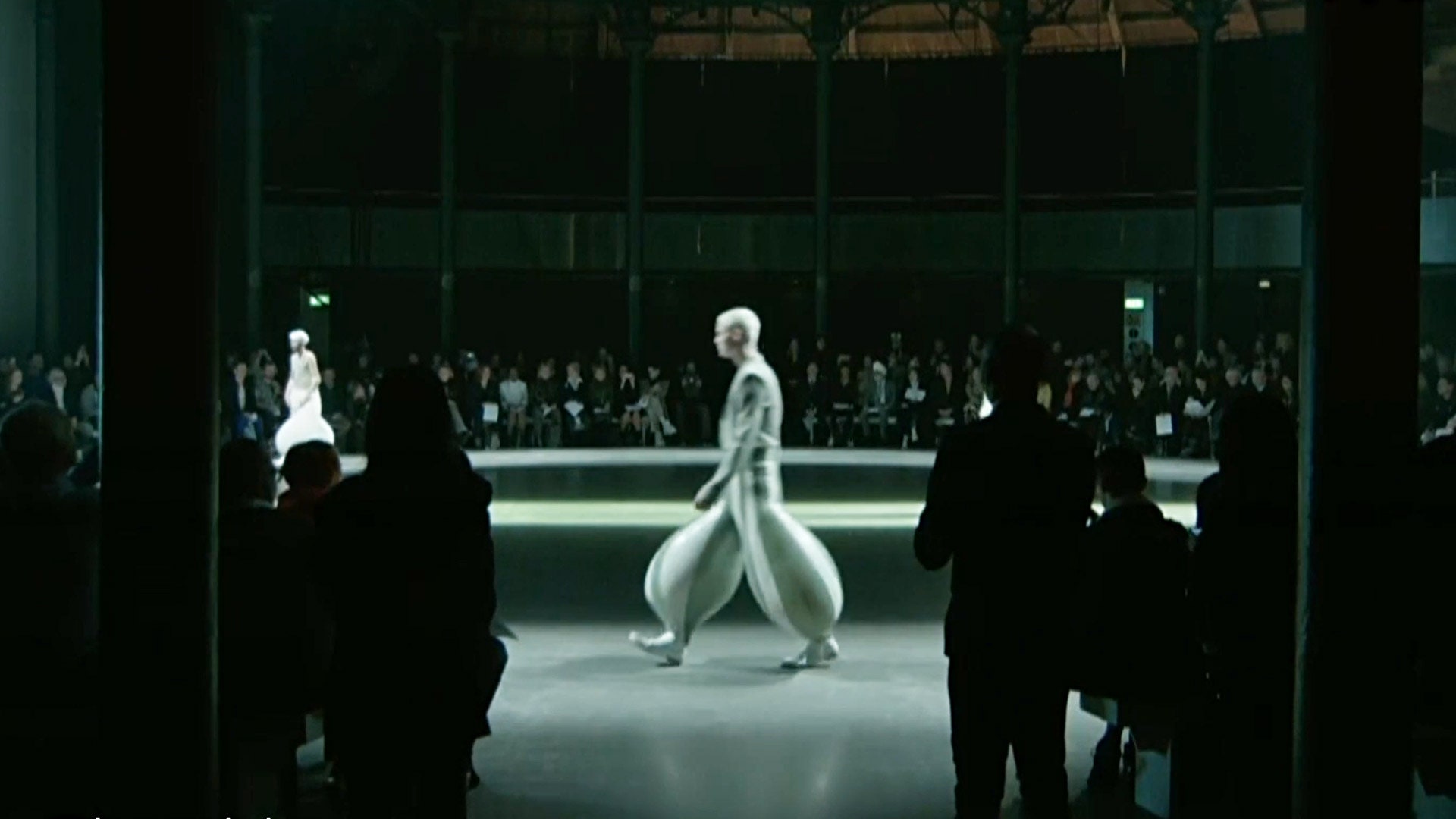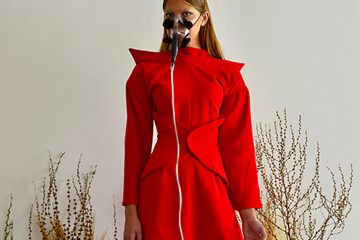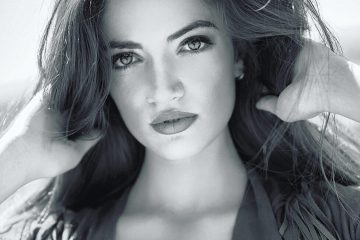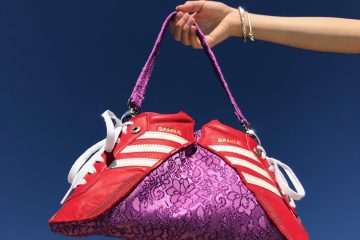Harikrishnan, the most eye-popping collection of London Fashion Week.

Fashion designer, Harikrishnan, impressed the whole fashion industry last february with his collection during London Fashion Week. This collection has details that escape beholders’ eyes and we could learn about them first hand in an interview with the designer. Coffee in hand, Hari shares how he remembers this sublime moment within other current issues that have defined his aesthetic as designer and his personal view on the develop of fashion.
Welcome to Tame! Nice to meet you Hari! Firstly, congratulations on your collection! It was such a moment in fashion that it got to be on the news everywhere. Did you ever imagine having such a big impact?
Hi! Great to meet you too! Thanks a lot! No, not at all, It surprises me.
Thanks a lot for sharing some of your time with us. We want to start talking about your origins. You come from Kerala, India. Your country is very traditional when it comes to fashion. How did you feel when you discovered occidental fashion especially in such an avant-garde city as London.
The place where I come from is a small coastal town in India. In my place, there is no “fashion”, our custome is something like a white shirt, a white sarong for men and a white sari for women. So, I have grown seeing that. I have never perceived fashion as a form of expression until I was 19. The body of work you can see in my collection, I have only been practising for only 4 years, just that. When I moved out from my hometown to pursue BA, I started with basic tailoring, patterns and women clothing. After my BA, I worked for a fashion designer in Delhi and I got some international exposure by then without leaving the country.
However, when I moved on to London, it was a bit of a shocking experience for me as the education is very different from the one I had in India. I had to unlearn everything I learned back in India and start fresh. Also, when you compare the way they guide fashion and the design processes are very different from other cities like France or New York. In London, it is more academic, so you do more research whereas in India, it is more visual, helping you create visual elements. So, when I studied my MA in London, it helped me learn a lot, I would say I learned 5 years of studies just in an year. In my opinion, it is the best place to study fashion because it is a bit more deep and there is a lot of value to fashion in academics.

As you mentioned in other interviews, the inspiration of your collection came while walking with your dog and it is about how the silhouettes of the human body look from a dog’s view when they look at us. How do you find inspiration for your collections?
That is something that always works, whenever I pick a concept for my design processes. I always choose something I can relate to or that happens in my life instead of choosing a culture or historical topic like punk, Queen Isabel II or The French Revolution because these are things I don’t have experience with or haven’t seen in my life. My dog is something very personal to me, of course. Also, having a dog is very universal at the same time. You might have a dog and many people might have a dog too. The experience I had with my dog is very relatable to many people in a way, I believe it is a good story to tell people through my collection.
It was a fun inspiration. However, the thought of a dog’s point of view is a very hard thing to work with in a fashion collection because you need visual elements to start with. Using the same example as before, when choosing an historical fact as The French Revolution, you have a lot of references, you can pick and use both visual and verbal. However, working with this idea, makes you think like: Okay, I need to extract things out, this is too abstract. It was a bit hard work and sometimes it could get personal.
This such overwhelming presentation makes clear you have a wise knowledge of fashion. Moreover, you interpret it very personally too. How would you say fashion has evolved in the last years? How have you adapted to it?
I realized many things during the MA. In my research, I found out Fashion hasn’t changed much in the last 10 years. From the 70’s to the early 2000’s there were many things going on and there was a kind of big revolution in the fashion industry. Maybe it stopped evolving from there. In the last years, brands are playing very similar plays and in terms of visual aspects not much has changed.
Around 2010, social media arrived and it stopped fashion from being a niche thing. Now, fashion is more diluted, everybody has a voice and can have an impact even on high fashion. I know if I put a design out anybody is going to see it from any country.
I didn‘t want my collection to be another brick on the wall. So, I really wanted to create something that is fresh and forward. I made sure that it wasn‘t something that has been done before. When people are on social media, they just scroll fast to the next post because they see the same things over and over again and I want people to stop when they see my designs because they get impacted visually with them.

Nowadays, designers are exploring new materials and giving new uses to others. You made this with your unique inflatable latex trousers completely changing the sexualized idea normally associated to this material. However, you also kept tradition by your side giving an alternative use to it. How do you choose the materials you will work with?
This is the way I see my design choices. We are very unique people, I come from a different country, with different education and family traditions. I know many people and I have lived many experiences. These things make me who I am . To me, fashion is a way of communication and it is where all these things come into place helping me build my design language and vocabulary.
The handcraft material I used was from a small community in Channapatna. A village close to where I studied my BA. So, I was exposed to this traditional handcraft since it was there and it’s been a part of my life. Therefore it was a natural choice I made to include them in my collection. Normally, when we do a collection we tend to look on the internet “first” for materials. However, We should look around us because we already have enough stimuli and those would make our collection unique and avoid repetition. That will become a true representation of yourself.
Your collection has a clear contrast in the use of materials, latex and handcrafted wooden beads. How did you introduced sustainability in this project?
Sustainability is a hard topic. For me, sustainability is more of a way of life and mindset. I tried to be as conscious and aware about my methodologies.
There is an ethical aspect in my collection which is the inclusion of handcrafted materials, because it wasn´t that I just included it in my collection. I adapted the whole traditional process and put it in a different context in fashion. So, in a way the community- Channapatna, has a new thing to work on now, they can take it in any direction possible.
In terms of latex, I managed to get all from my sponsor, Supatex. They provided me all the surplus of whatever was left in the factory. So, the only fresh latex was the white colour which was produced especially based on my order. Normally, it isn’t produced in bulk because it gets dirty quickly. This let me cost down the price of the collection significantly which is a good thing for any graduate…

Sometimes it is difficult for some people to understand such experimental and visual collections like yours. There is an anecdote about one of the models who refused walking on the fashion show because he wouldn’t be able to look serious. How did you cope with the situation at the fittings? What would be an fun anecdote you remember of this day?
There were always problems at the fittings, models were always laughing at the trousers. Years back models were forced to wear anything but I am happy that the industry respects their choices because my creations will never look good if they aren‘t feeling comfortable.
A fun thing that happened to me was that before the show during London Fashion Week Presentation. I had another show, which was the In House show at university. For the In House show, I only got one month to make the tailored jackets, another month and a half for the wooden beaded outfits and two months to make the trousers from cutting, sticking to finishing, which is a very short time for 9 inflatable trousers. It could take up to 3 days to finish just one. After all, I managed to make as many shapes as possible even though doing different patterns was risky considering the time limitation. As a consequence, I didn’t get much time to fit them on different people or see how much time would it take to fill them with air until the show day. The night before the show, I finished sealing my ninth trouser. The day of the first show, I was backstage seeing my first model walking on the runway and I was literally having a heart attack because if there was any problem with the trousers people would laugh at me with no doubt and It would be so unfair after so much hard work. Thinking back this was a very risky collection.
Also for both shows, I was always the first one because my outfits took time to put. But I didn’t want models to be in the garments for too long to avoid accidents. Unfortunately models had to wait 30 minutes backstage… 30 minutes of heart attack, ha ha. The In house Show was only seen by my colleagues and people from uni. But Fashion Week was different with the press, industry and much more people so it was a series of heart attacks.













